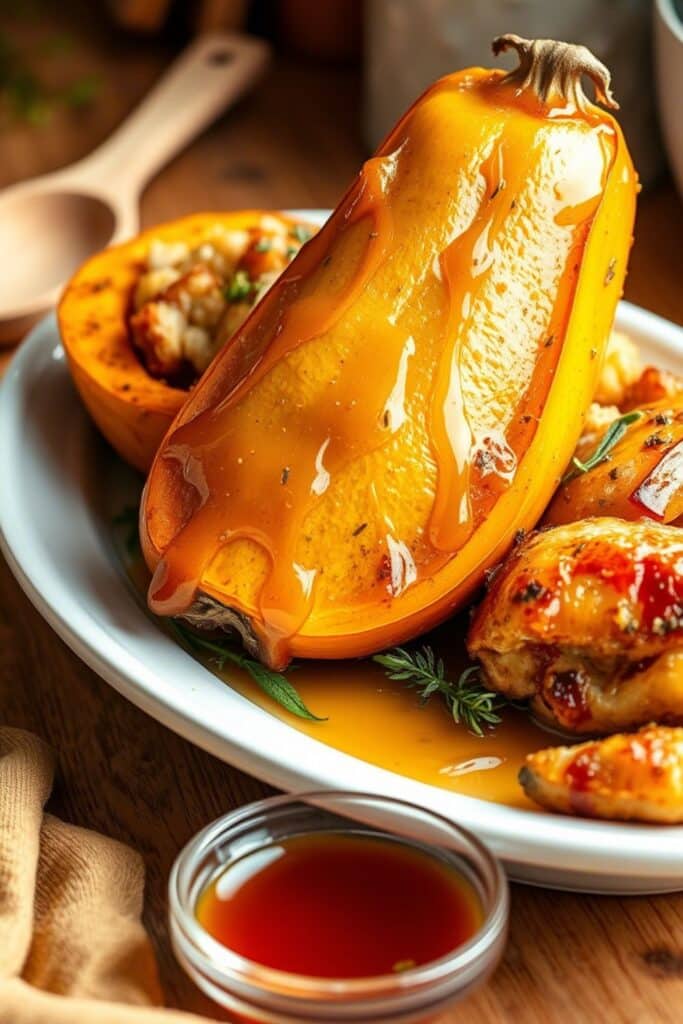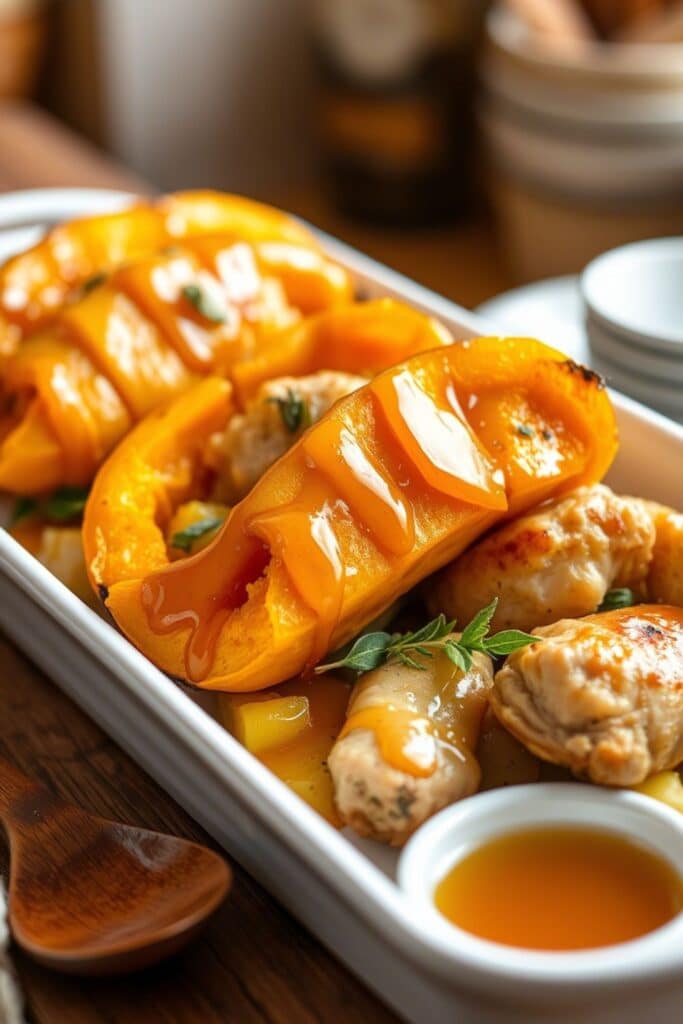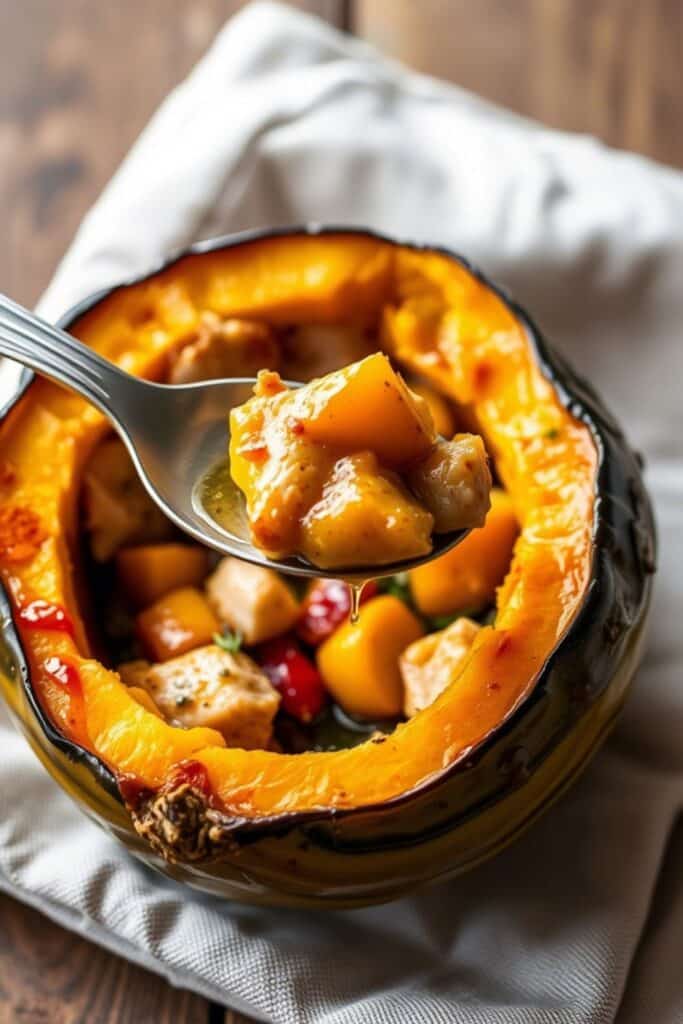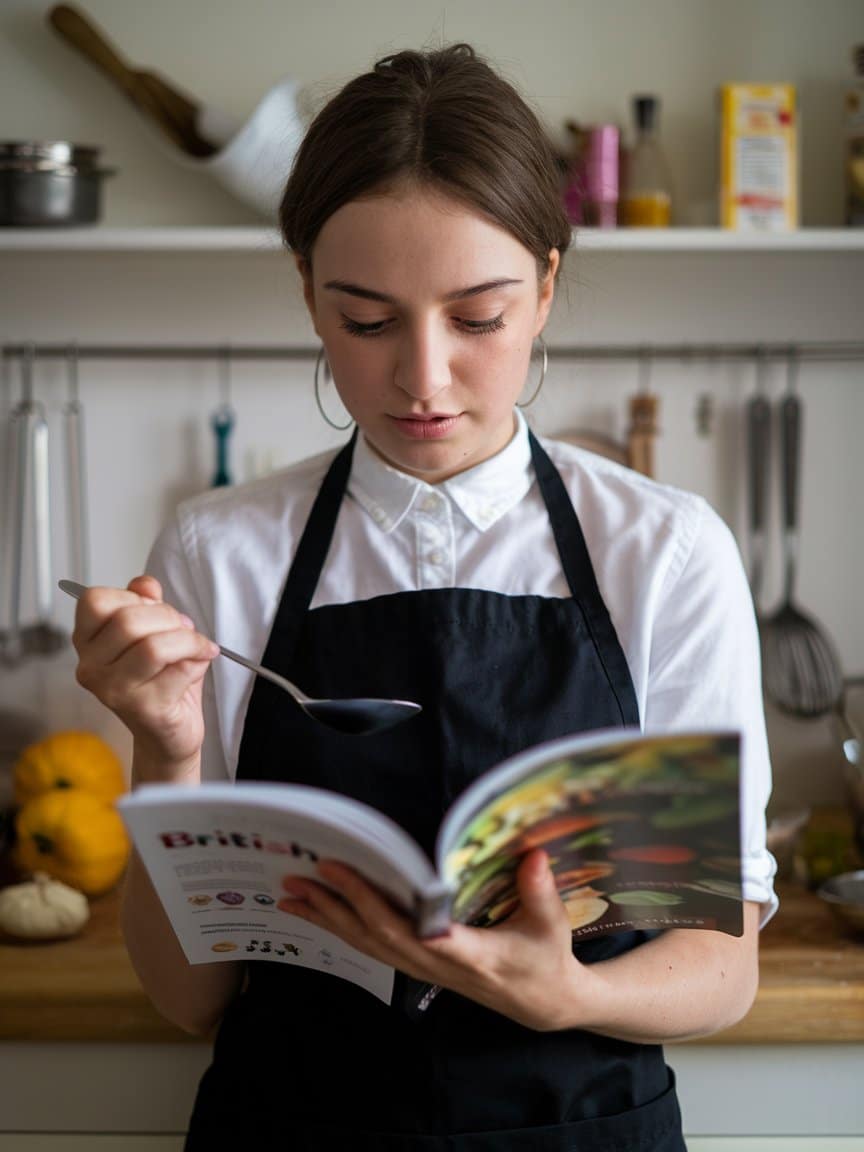The first time I served honey roasted butternut squash stuffed with chicken to my dinner guests, the entire table fell silent. Not because something was wrong quite the opposite. The golden, caramelized squash gleaming under the dining room lights, its cavity brimming with herb-scented chicken, had rendered them speechless. One guest actually put down her fork mid-bite just to photograph the dish.
This isn’t your grandmother’s stuffed squash recipe. While traditional preparations often rely on breadcrumbs and vegetables for filling, this sophisticated approach transforms humble butternut squash into an elegant centerpiece that bridges the gap between comfort food and fine dining. The natural sweetness of honey-glazed squash creates a perfect counterpoint to savory, herb-crusted chicken, while the roasting process melds flavors in ways that will surprise even seasoned cooks.
What makes this dish truly special is its versatility and visual impact. It works equally well as a show-stopping holiday centerpiece or an intimate dinner for two. The technique of stuffing and roasting creates layers of flavor that develop throughout the cooking process, with the squash becoming tender and caramelized while the chicken remains juicy and aromatic.
Ingredients & Substitutions
The foundation of exceptional cooking lies in selecting the right ingredients, and this recipe rewards quality choices at every turn.
For the Butternut Squash:
- 2 large butternut squash (3-4 pounds each), halved lengthwise and seeded
- 1/3 cup raw honey (preferably wildflower or clover)
- 3 tablespoons olive oil
- 2 teaspoons kosher salt
- 1 teaspoon freshly cracked black pepper
- 1/2 teaspoon smoked paprika
For the Chicken Filling:
- 1.5 pounds boneless, skinless chicken thighs, cut into 1-inch pieces
- 1 large yellow onion, finely diced
- 3 cloves garlic, minced
- 1 cup wild rice blend, cooked
- 1/2 cup dried cranberries
- 1/2 cup toasted walnuts, roughly chopped
- 2 tablespoons fresh thyme leaves
- 1 tablespoon fresh sage, chopped
- 1 teaspoon ground cumin
- 1/2 teaspoon cinnamon
- 3 tablespoons butter
- 1/2 cup chicken stock
When selecting butternut squash, look for specimens with a long neck and small bulb this shape provides more usable flesh and a better cavity for stuffing. The skin should be matte rather than glossy, indicating proper ripeness. If butternut squash isn’t available, delicate or acorn squash work as substitutes, though cooking times will need adjustment.
Chicken thighs are preferable to breasts here because their higher fat content prevents drying during the extended roasting time. However, if you must use chicken breasts, consider adding an extra tablespoon of butter to the filling mixture. For those following dietary restrictions, turkey thighs or even firm tofu can replace the chicken, though the cooking time may vary.
The honey selection matters more than most home cooks realize. Wildflower honey offers complex floral notes that complement the squash’s earthiness, while buckwheat honey provides a more robust, almost molasses-like depth. Avoid heavily processed honey, as it lacks the nuanced flavor profile this dish demands.
Wild rice blend adds textural interest and nutty flavor, but regular brown rice or even quinoa work as substitutes. If using quinoa, reduce the liquid slightly as it absorbs less moisture than rice.
Step-by-Step Instructions

Preparing the Squash Foundation
Preheat your oven to 400°F and position the rack in the center. This temperature strikes the perfect balance between caramelizing the squash exterior and cooking it evenly throughout.
Cut each butternut squash in half lengthwise, then scoop out the seeds and stringy pulp using a large spoon or ice cream scoop. Don’t worry about getting every last bit some remaining strands will cook down and add sweetness to the filling.
Score the flesh in a crosshatch pattern, making cuts about 1/2 inch deep. This technique, borrowed from French cooking, increases surface area for better caramelization and helps the honey penetrate deeper into the flesh.
In a small bowl, whisk together honey, olive oil, salt, pepper, and smoked paprika until well combined. The mixture should have the consistency of thin syrup. If your honey has crystallized, warm it gently in the microwave for 20-30 seconds before mixing.
Brush the honey mixture generously over the cut surfaces of the squash, making sure it gets into the scored lines. Place the squash halves cut-side down on a rimmed baking sheet lined with parchment paper. The parchment prevents sticking and makes cleanup easier.
Roast for 35-40 minutes, until the flesh is tender when pierced with a fork but still holds its shape. You’re looking for al dente rather than mushy the squash will continue cooking when stuffed and returned to the oven.
Creating the Chicken Filling
While the squash roasts, prepare your filling. Heat a large skillet over medium-high heat and add one tablespoon of butter. Once it stops foaming, add the diced chicken thighs in a single layer. Don’t overcrowd the pan work in batches if necessary.
Let the chicken sear undisturbed for 3-4 minutes until golden brown. This initial searing creates fond (those beautiful brown bits) that will add depth to your filling. Turn the pieces and cook another 2-3 minutes until cooked through but still slightly pink in the center they’ll finish cooking in the oven.
Remove chicken to a plate and add the remaining butter to the same pan. The leftover fond will melt into the butter, creating an instant flavor base. Add diced onion and cook until softened and lightly caramelized, about 6-8 minutes.
Add minced garlic, thyme, sage, cumin, and cinnamon. Cook just until fragrant, about 30 seconds. Overcooking the garlic at this stage will make it bitter, so watch carefully.
Return the chicken to the pan along with cooked rice, cranberries, and toasted walnuts. Pour in chicken stock and stir gently to combine. The mixture should be moist but not soupy if it seems dry, add stock a tablespoon at a time.
Season with salt and pepper to taste, keeping in mind that the squash will add its own sweetness to balance the flavors.
Assembly and Final Roasting
Remove the roasted squash from the oven and carefully flip each half cut-side up. They’ll be very hot, so use tongs or a spatula to avoid burns. The flesh should be golden and slightly caramelized around the edges.
Using a fork, gently scrape some of the squash flesh from the sides and bottom, leaving about 1/2 inch of flesh as a border. This scraped flesh can be mixed into the filling for extra richness don’t waste it!
Divide the chicken filling evenly among the four squash halves, mounding it slightly in the center. The filling should dome above the rim of the squash cavity it will settle as it cooks.
Return to the oven and roast for an additional 25-30 minutes, until the squash is completely tender and the filling is heated through. The top of the filling should be lightly golden, and you should be able to easily pierce the squash walls with a knife.
Cooking Techniques & Science
The magic of this dish lies in understanding how different cooking methods interact to create complex flavors. The initial roasting of the squash cut-side down serves multiple purposes: it prevents moisture loss, promotes even cooking, and allows the natural sugars to concentrate rather than evaporate.

When we score the squash flesh, we’re applying a technique called “slashing” that’s commonly used in bread baking. The cuts create channels for the honey mixture to penetrate, ensuring flavor reaches the interior rather than just coating the surface. This method also creates more surface area for the Maillard reaction the chemical process responsible for browning and flavor development.
The honey glaze undergoes its own transformation during roasting. As the water content evaporates, the natural sugars concentrate and caramelize, creating those gorgeous golden-brown edges. The addition of smoked paprika isn’t just for color it provides a subtle smokiness that complements the sweet caramelization without overwhelming the dish.
Searing the chicken thighs before adding them to the filling is crucial for flavor development. This technique, known as “fond formation,” creates those brown bits that contain concentrated umami flavors. When we deglaze the pan with butter and aromatics, we’re capturing all those flavors and incorporating them into the filling.
The choice of chicken thighs over breasts isn’t arbitrary thighs contain more intramuscular fat and connective tissue, which break down during the long roasting process, keeping the meat moist and flavorful. Breasts, being leaner, tend to dry out under these conditions.
Temperature control is critical throughout this process. Too high, and the squash exterior will burn before the interior cooks through. Too low, and you won’t achieve proper caramelization. The 400°F temperature represents a sweet spot that allows for proper cooking while developing those essential flavor compounds.
Serving & Pairing Suggestions
Presentation of this dish should highlight its natural beauty rather than mask it with excessive garnishes. I like to serve each stuffed squash half on individual plates, garnished simply with a sprinkle of fresh thyme leaves and perhaps a drizzle of the pan juices.
For wine pairings, consider a Viognier or Chardonnay with enough body to match the dish’s richness but sufficient acidity to cut through the honey sweetness. Red wine enthusiasts might opt for a Pinot Noir from Oregon or Burgundy something with earthy undertones that complement the squash without overwhelming the delicate chicken flavors.
Side dishes should complement rather than compete with the main attraction. A simple arugula salad with lemon vinaigrette provides peppery contrast to the sweet squash. Roasted Brussels sprouts with bacon offer textural variety and additional savory elements.
For holidays or special occasions, consider serving this family-style on a large platter, garnished with pomegranate seeds for color contrast and fresh herbs for aroma. The visual impact is stunning, and guests can serve themselves portions according to appetite.
The dish also works beautifully for meal prep leftover portions reheat well in a 350°F oven for about 15 minutes, covered with foil to prevent drying.
Common Mistakes and Troubleshooting
One of the most frequent errors I see is overcooking the initial squash roasting. Remember, the squash needs to maintain some structure for stuffing if it’s mushy after the first roasting, it will fall apart completely during the second phase.
Another common mistake is underseasoning the filling. Since the squash itself is quite sweet, the chicken mixture needs assertive seasoning to create proper balance. Don’t be afraid to taste and adjust seasoning before stuffing.
Choosing the wrong squash can doom the dish from the start. Avoid squash that feels light for its size (indicating dehydration) or has soft spots. The stem should be intact and the skin should be free of cuts or bruises.
If your honey crystallizes during storage, don’t throw it away gentle warming will restore its liquid state. However, avoid overheating, as this can destroy the delicate flavor compounds that make good honey special.
Temperature monitoring is crucial but often overlooked. If you don’t own an instant-read thermometer, invest in one. The chicken filling should reach 165°F internal temperature to ensure food safety.
Creative Variations and Seasonal Adaptations
This recipe serves as an excellent foundation for seasonal variations. In fall, try adding diced apples and pecans instead of cranberries and walnuts. Winter versions might incorporate dried figs and hazelnuts, while spring adaptations could feature fresh peas and mint.

For those following ketogenic diets, simply omit the rice and increase the chicken portion. The squash provides enough starch to make the dish satisfying without additional grains.
Vegetarian versions work surprisingly well substitute mushrooms for chicken, using a mix of cremini and shiitake for complex umami flavors. Vegetable stock replaces chicken stock, and a handful of crumbled goat cheese adds richness.
International flavors adapt beautifully to this format. Try Moroccan-inspired spicing with cinnamon, ginger, and preserved lemons, or go Mediterranean with olives, sun-dried tomatoes, and feta cheese.
The cooking method translates well to other winter squashes too. Acorn squash works particularly well, though you’ll need to adjust cooking times. Delicata squash offers a slightly different flavor profile with its creamy, potato-like flesh.
For entertaining, this dish can be prepared largely in advance. Complete the first roasting of the squash and prepare the filling up to a day ahead. Assemble and complete the final roasting just before serving.
Final Thoughts
Mastering this honey roasted butternut squash stuffed with chicken represents more than just following a recipe it’s about understanding how flavors develop, how techniques build upon each other, and how simple ingredients can be transformed into something extraordinary.
The dish exemplifies seasonal cooking at its best, celebrating the natural sweetness of winter squash while providing the hearty satisfaction needed during colder months. It’s proof that elegant cooking doesn’t require exotic ingredients or complicated techniques, just an understanding of how to coax the best from what you’re working with.
Don’t be intimidated by the multiple steps each phase builds logically on the previous one, and the active cooking time is quite manageable. The reward is a dish that looks and tastes like it came from a fine restaurant kitchen but was created in your own home.
Most importantly, this recipe teaches valuable lessons about balancing sweet and savory flavors, using proper roasting techniques, and presenting food in ways that honor the ingredients. These skills will serve you well across countless other recipes and cooking adventures.
Frequently Asked Questions?
Q: Can I prepare this dish ahead of time for entertaining?
A: Absolutely! You can complete the initial squash roasting and prepare the chicken filling up to 24 hours in advance. Store the roasted squash halves and filling separately in the refrigerator. When ready to serve, bring both components to room temperature (about 30 minutes), stuff the squash, and complete the final roasting. This actually improves the flavors as the components have time to meld.
Q: What should I do if my squash is cooking unevenly?
A: Uneven cooking usually results from size differences or inconsistent oven hot spots. If you notice one half cooking faster than others, tent it with foil to slow the browning while the others catch up. For future preparations, try to select squash of similar sizes, and rotate your baking sheet halfway through cooking to compensate for oven variations.
Q: My honey mixture seems too thick/thin. How can I adjust it?
A: Honey consistency varies significantly based on type and storage conditions. If your mixture is too thick, warm it gently in the microwave for 15-20 seconds, then whisk in a tablespoon of warm water. If it’s too thin, let it sit at room temperature to thicken naturally, or add a pinch of salt which will help it cling better to the squash surface.
Q: Can I substitute the wild rice blend with other grains?
A: Yes, several alternatives work well. Quinoa provides similar texture with less cooking time use about 3/4 cup uncooked quinoa. Brown rice works perfectly but may need extra stock since it absorbs more liquid. Farro adds a wonderful chewy texture, though it requires longer cooking. Avoid regular white rice as it tends to become mushy during the extended roasting time.
Q: How do I know when the chicken filling is properly seasoned?
A: The key is balancing the filling’s savory elements against the squash’s natural sweetness. The filling should taste slightly over-seasoned on its own remember, it will be mellowed by the sweet squash. I recommend making the filling, letting it cool for a few minutes, then tasting with a small piece of raw squash to simulate the final flavor balance. Adjust salt, pepper, and herbs accordingly.

Veronica is a passionate food enthusiast with over three years of experience in exploring and writing about diverse cuisines. Her expertise lies in reviewing restaurants, sharing creative recipes, and discovering the latest food trends. As the voice behind FoodieRecap.com, Anju brings fresh perspectives and culinary insights to her audience.
